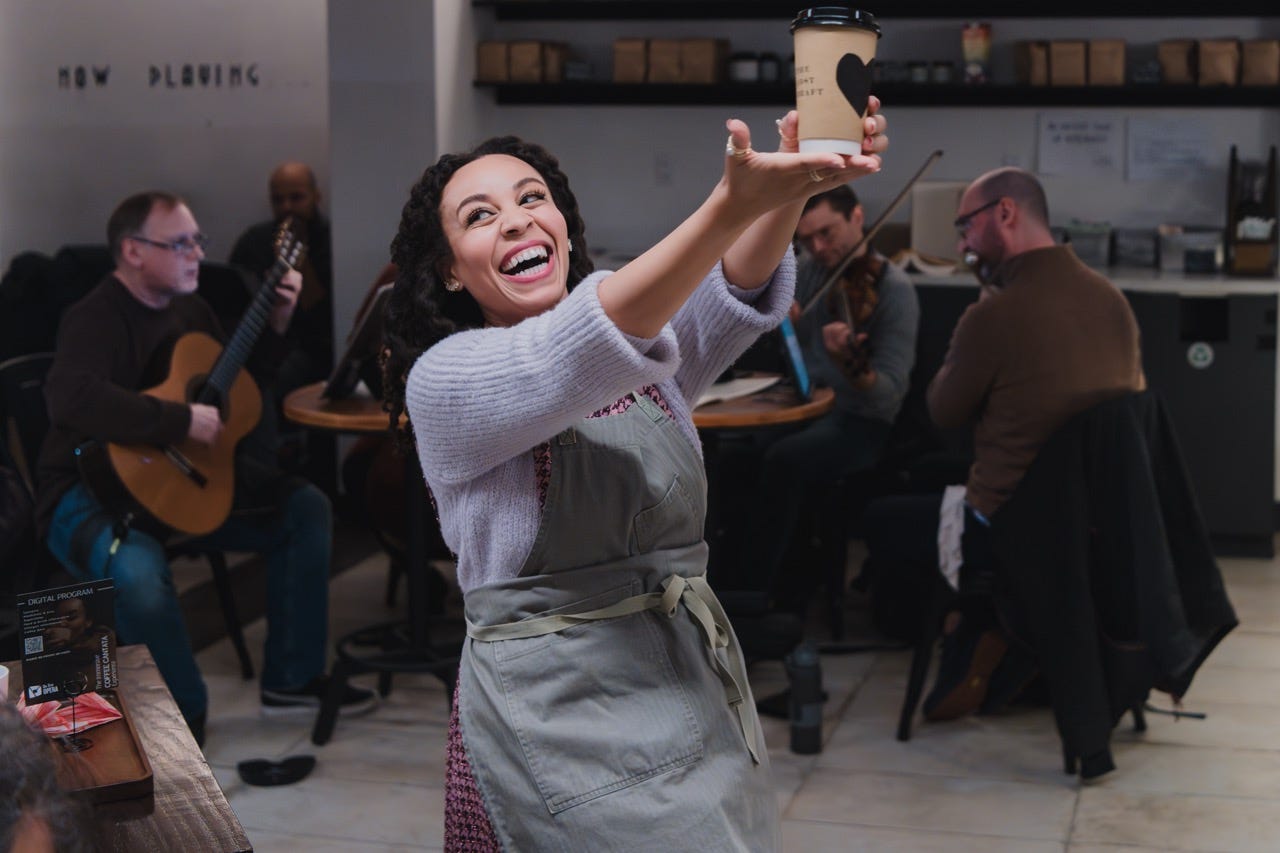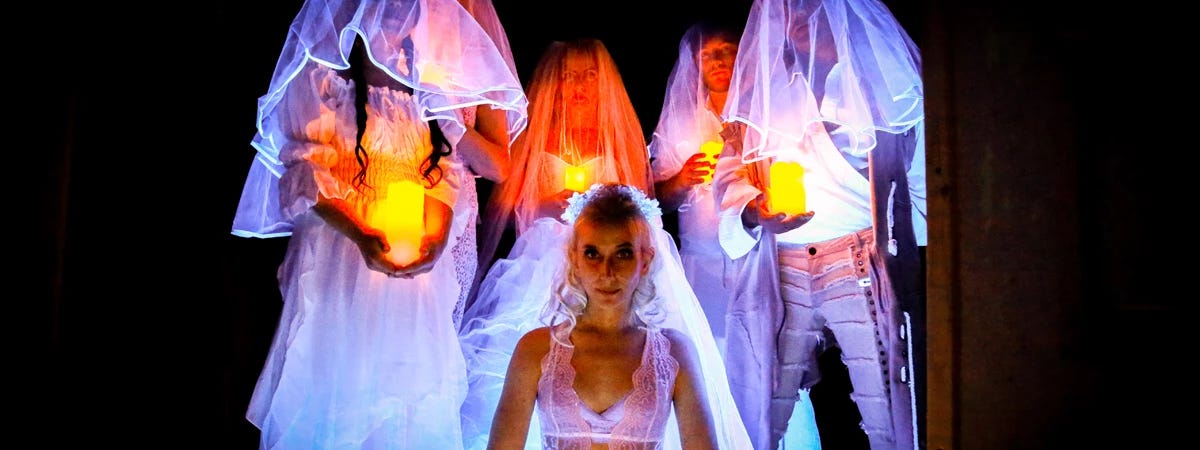Review Rundown: The One With Fairy Tales, Coffee, and Murder
NYC, LA, London, Online, and a transcendent trip to sonic space in Boulder (SIX REVIEWS)


We’re back in the thick of it with a six review edition that covers theatre, audio experiences, murder mystery, and VR installation art.
In other words very on brand.
Six is a lot, but we know you. You want MOAR.
Last week’s Rundown is waiting for you and can start your run to the top of the year. Plus we put out “NoPro’s 10 Most Anticipated New Immersive Works of 2024 (Part I)” not that long ago!
Are you a creator who looks upon these reviews with envy? Okay, the positive ones, at least? Then you might want to check out our UPDATED How To Get Covered By NoPro guide.
Want to get listed in our newsletter and have your event shared with our social media following? Submit a listing to Everything Immersive.
Get the NoPro Newsletter and access to our Discord by becoming a Patreon backer today!
Heartbreak and Magic — Libby Heaney, VIVE Arts, Somerset House
£6; London UK; run concluded
Art installation-cum-VR experiment Heartbreak and Magic took up short-term residency in Somerset House’s New Wing, where visitors could come across the artwork and slip into the headset for a 10-minute dip in the shallow end of virtual interactivity.
Surrounded by multimedia artwork, the audience experience primarily takes place on a rotating stool with a VR headset and adapted handheld controls. There’s a few opportunities to engage with the virtual “performance” but in general the piece is very passive — mostly we are taken on an impressionistic journey down the well of the artist’s immense grief.
Occasionally at risk of drowning in it.
Resident artist Libby Heaney’s qualifications as a quantum physicist are impressive, however the digital artwork itself (while reportedly based on quantum physics and certainly unique, at times beautiful) may be too cerebral for maximum audience affect. We have only to admire the shapes and colors, drifting through a boundless cloud of digital paintings with a whisper of narrative. Maybe it’s advanced mathematics and the future of the VR industry, but if we have to ask, it’s probably too early days to tell.
In terms of “immersiveness”, I get the sense that one of two things went wrong: either the artist intended a certain environmental/emotional atmosphere for visitors which wasn’t delivered in full earnest by the venue staff, or the headspace of the audience wasn’t really considered by anyone, resulting in the audience’s physical and emotional journey from the hallway into the VR space was just so many awkward steps from Point A to Point B, and back out again.
In general, Heartbreak and Magic comes across as exactly what it is: an artist’s first-time foray into the realm of virtual reality and the immersive/interactive genre, with eons of space and time for future development.
— Shelley Snyder, London Curator

The Immersive Coffee Cantata Experience — On Site Opera
$40; in-person; running through February 25th (sold out — waitlist available)
On Site Opera had staged site-specific opera productions in a myriad of surprising locations: the interior of an 1800s sailing ship, a Manhattan soup kitchen and The Museum of Natural History’s hall of dinosaurs. Now, the adventurous troupe present Johann Sebastian Bach’s rarely produced “comedic miniature” Schweigt stille, plaudert nicht, also known as the Coffee Cantata, inside chic Nolita coffee shop The Lost Draft.
This modest piece, scored sometime between 1732–1735, was originally written by Bach for concert performance. On Site have crafted an experiential staging, with the audience served at tables like coffee house patrons while the action moves around us. Three different coffee tastings are offered over the course of the show, along with two delicious cookies and some really good popcorn.
The libretto is simple. A narrator (Bernard Holcomb) explains that Schlendrian (Philip Cokorinos) is dismayed by a new coffee habit picked up by his daughter Lieschen (Teryn Kuzma at my performance, but principally Christine Lyons). Father attempts various strategies to convince his daughter that coffee is an unnatural drug, and she must give it up if she ever hopes to marry.
The staging, by Sarah Meyers, is witty and inventive, with smooth choreography that enhances the piece while never distracting from the score. Added bits of business, like the Narrator doubling as a barista who pushes coffee’s wonders, feel seamlessly blended in. Bach’s perky melodies sound crisp played by a four-piece orchestra under Greffrey McDonald’s music direction. The score is a light meal at just 30 minutes, but has sumptuous moments, particularly Lieschen’s aria extolling her love of coffee.
The pleasure of this delightful evening lies mainly in the experience On Site have so lovingly crafted. On a frigid night in New York, the whole experience felt like a warm hug, a happy escape to a world of luscious melodies and pleasing aromas.
— Joey Sims, NYC Correspondent
Murder at the Speakeasy- Dramatic Exit, LLC.
$45; Los Angeles; Run Concluded
I don’t know about you, but I love any event that gives me the opportunity to dress up in a fun period outfit and sip on cocktails. Insert Murder at the Speakeasy. The name suggests it all, there was a murder and you’re at a speakeasy. I immediately knew this was something I wanted to attend.
If we’re going to strip it all the way down, this show is an old-fashioned “who dunnit.” Your engagement with the show is dependent on your willingness to help solve a mystery and interact with the suspects. Upon check in, you find a seat, order a drink, and get cozy as the characters work the room and introduce themselves. Some things they say may come in handy later, but this is the part where you can really dig in and get lost in the speakeasy.
The show begins with a beautiful and captivating burlesque performance by the resident star, Tildie O’Brien (Sarah Louise, aka Lucy Zeigfeld). We’re then welcomed by the boisterous club owner, Angel (Timothy Portnoy) who is overjoyed to announce his club is now murder-free (until it’s not). We also meet a drunk, yet celebrated poet Edith Sinclair (Ashley J Woods) and Tildie’s obsessive stalker and assistant to Angel, Jimmy the Dog (Jacon Marvin Eneberg). It’s not long until the murder-free club experiences a murder and we meet the begrudging Detective Murphy (Adam Whittington). I’ll keep this review spoiler-free, as this show may pop up again soon, but what follows is a hilarious evening of flashbacks and searching for clues while puzzle-solving.
In addition, three audience members are recruited to play suspects. Through the use of cards with dialogue and performer direction, the interactions with the audience members feel seamless and match the slap-stick and jovial tone of the rest of the show. Lines feel blurred as the rest of the audience members ask questions and name a killer.
Again, I won’t spoil any of that for you, but I will say that the performers were engaging and funny and created a welcoming atmosphere to solve a murder in this newly-christened murder-free club. The audience volunteers were utilized the perfect amount, allowing them to still enjoy the show and the non-volunteers were treated to the spontaneity that comes with live theater and volunteers.
Get No Proscenium’s stories in your inbox
Join Medium for free to get updates from this writer.
SubscribeSubscribe
This show is perfect for dates as well as large groups (I attended with a group of 7 and everyone in my group left with a smile on their face). I personally love the Roguelike Tavern, so this location for this show was definitely a bonus, as I got to enjoy my favorite libation, the Bees Knees, as the show played on. Although I knew the outcome and the murderer, the performances by the cast were so captivating that I would absolutely go back. This show is not scary, and features adult themes (this is burlesque at a speakeasy, after all.)
— Briana Roecks, Social Media Correspondent

Söm-Sãptälahn — Itchy-O
$36.50; Boulder, CO; Run Concluded
Itchy-O’s most recent engagement, Söm-Sãptälahn, brought me to the University of Colorado campus in Boulder. There, I found a seat inside Fiske Planetarium — the largest planetarium between Chicago and Los Angeles — and settled into my cushioned, reclining auditorium seat for 60 minutes of relaxation, reverberation, and guided meditation.
The lights dimmed and millions of stars appeared overhead. A door opened to the right and, although I could not see them, I could tell some members of Itchy-O had entered the room by the rhythmic clank and clunk of their bells, gongs and cymbals and the silhouetted procession of their tall, rounded tophats.
Next, several Kriechen — Itchy-O’s iconic, female-presenting dancers with creepy, pointy fingers and fully-shrouded heads and torsos — performed a tribal-like movement sequence that had the effect of controlling the rotation of the stars above us.
I was mesmerized.
The Kriechen exited, the stars faded, and my attention was drawn to a set of pulsating, concentric rings projected on the dome overhead. A friendly, robotic voice slowly and methodically guided us through a series of mental prompts and meditations. (Any Itchy-O backers who listened to their 2021 Noise Bath series would be quick to recognize the voice.)
We spent a generous amount of time in this act, and the visual projection slowly grew to eventually overtake the entirety of the domed screen above us. The longer I stared at the pulsating circles, the more it looked like a giant, swelling black hole ready to suck me in.
I was entranced.
The entire time this was happening, I was engulfed in sound that felt like Itchy-O was on the perimeter of the room, playing in the round, but when I looked, they were nowhere to be found. It was their original score, but a high quality recording projected throughout the room.
Four more acts of similar mind-bending meditation, visualization, and sound ensued, lapping up our hour together in what felt like 20 minutes. Reflecting on this truly one-of-a-kind event, Itchy-O continues to fascinate and amuse me with music-centric events that somehow manage to completely circumvent the traditional idea of going to see live music. Would you like to go to a concert that’s not a concert, by a band that’s not a band? Then step right up and grab yourself an Itchy-O ticket to whatever comes next from this 50+ member collective’s strange little corner of the universe. You won’t be disappointed.
— Danielle Riha, Denver Correspondent

The Tempest: A Surround Sound Odyssey — Knock at the Gate
$9.99; Online; Through March 1
The Shakespearean canon provides many opportunities for the modern sound designer, whether crafting a war soundscape from a history play to light supporting music in a comedy. But in his two most magical plays, A Midsummer Night’s Dream and The Tempest the avenues for sound design widen into boulevards that can redefine the narrative told. Down one such street barrels Knock At the Gate’s online headphone audio production of The Tempest, which enthusiastically charts a new technological course but laboriously lands at a traditional destination.
For the uninitiated, Shakespeare’s The Tempest revolves around usurped Duke of Milan, the magical Prospero (Joel de la Fuente), conjuring up a storm (made sonically manifest by Leigh Roberts) to bring his brother, the usurping Duke of Milan Antonio (Patrick Toon), King of Naples Alonso (Shane Taylor), and traveling party to the magical island where Prospero has been exiled. Once all parties are scattered around the Island, Prospero, with the help of his magical servant Ariel (Hale Appleman), covertly manipulates the various character groupings so that the young lovers fall in love, the villains are shown for who they are, and the drunkards end embarrassed.
The nuts and bolts of this Tempest are simple for the patron, listen to a show file on headphones in a dark place. By treating this text as effectively a very intimate radio play, the sonic imagery and occasional songs (co-written by Director Joseph Discher and the aforementioned Leigh Roberts) spring forth and define the spaces and characters, yet the experience loses steam as the run time progresses. Within the first two acts, most every trick of the sonic arsenal is hinted at with only the occasional page turn sound effect signaling a scene break. Despite the cast’s excellent faculty with Shakespearean text, the hundred minute runtime dragged under the weight of the three interlocking plots. If this was broken up into episodic chunks, it might make it a bit more palatable. But as it stands, its an excellent production for the Tempest newbie (if I were teaching the Tempest in a high school, this would be my preferred production for students to experience), but not necessarily a must do for the immersive community.

The Tiger’s Bride — Theatre Uzume
From $95; New York, NY; Through March 9th
It seems like fairy tale adaptations are everywhere right now and I can’t get enough of these retellings — especially retellings of the creepier, off-the-beaten path stories that are often overlooked.
Theatre Uzume’s The Tiger’s Bride is a retelling (or, to be nitpicky about it, a retelling of Angela Carter’s retelling) of the French folktale Bluebeard, the story of a young woman who marries a mysterious and rich nobleman whose previous wives have all gone missing. Spoiler, if you can call the ending of a 400-year-old fairy tale a spoiler: he’s murdered them all, as she discovers upon exploring her husband’s sprawling mansion.
Despite its macabre theme, The Tiger’s Bride was a lot of fun. Participants played the role of guests at the wedding of Bluebeard and the unnamed Bride, and are invited to explore the four-story mansion and mingle with its bizarre inhabitants after Bluebeard is called away on business and hands over a jangling ring of keys to his new wife.
We meet the various maids and manservants who work in Bluebeard’s mansion, their names — Snow, Monsieur Le Bete, Alice, etc. — all hat-tips to various fairy tales contained in Angela Carter’s 1979 book, The Bloody Chamber. Each of the mansion’s guests have something to show us — from magic tricks to weird dances — that helps the story of Bluebeard unfold. And all the while, members of the staff and the wedding party take turns twirling around on aerial silks and performing other circus tricks in the foyer.
The cast was, on the whole, charming and fun to interact with. The show was well-paced, never boring, and a simple card-stamping mechanism helped the audience to flow through the space without ever getting log jammed. It also had original live music performed by a string player who moved throughout the space.
Though The Tiger’s Bride was fun, I did have some issues with it that are largely conceptual. First, I’m not quite sure why it’s called “The Tiger’s Bride,” which is another story in Carter’s book that involves a woman turning into a tiger in Italy. Theatre Uzume’s show is obviously based on the titular story in the collection, “The Bloody Chamber,” which is a retelling of Bluebeard set in France — maybe that’s just not a romantic enough name for a show that debuted on Valentine’s Day?
I acknowledge this is a pretty trivial issue and would not dissuade most would-be patrons, but for me, it was emblematic of wider issues The Tiger’s Bride had with theme and consistency. Attendees were encouraged to dress as if we were guests at a 1920s wedding, but the show itself had virtually zero set or costume pieces to indicate that we were in the Jazz Age, aside from the Bride’s mother’s dress. The music wasn’t 1920s era, and letters in an upstairs desk were inexplicably dated in the 1940s.
Though the cast gave the show their all, and the venue (the cell) was gorgeous and fit-for-purpose, the costumes and wigs tended to look like cheap Halloween costumes and were inconsistent with the stated time period. The fact that our stamp cards had a number scratched out and replaced with hand-written sharpie also felt low effort. Is this a huge deal? Not really, but it did make me raise an eyebrow at the $95 entry-level ticket price.
Aside from my aesthetic gripes, I want to point out that one-on-one experiences in this show are not made available to general entry patrons, and instead are only for visitors with more expensive tickets, who are called over the intercom for their one-on-ones. This was not immediately clear, and led to some confusion and jockeying for position among the guests before people realized how the show worked.
That said, I had a fun time and would recommend the show to anyone who likes fairy tale retellings, circus-inspired shows, or is just looking for something kinda weird to do on a cold winter night.
–Cheyenne Ligon, NYC Correspondent
Discover the latest immersive events, festivals, workshops, and more at our new site EVERYTHING IMMERSIVE, home of NoPro’s show listings.
NoPro is a labor of love made possible by our generous Patreon backers. Join them today and get access to our Newsletter and Discord!
In addition to the No Proscenium website and our podcast, and you can find NoPro on Facebook, LinkedIn, YouTube, Instagram, and in the Facebook community also named Everything Immersive.